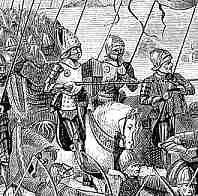


This document is in the form of a private charter in the French language, but it is essentially a receipt from a knight with the surname de Vallecouer who, with two other knights and 21 squires, provided forces to fight the English under the command of the count of Porcien. The technical term for this type of document is quittance in French, or acquittance in English. The document acknowledges his payment from the paymaster of the king's army. Porcien was in northern France, close to the Flemish border, so these were members of the local gentry defending their turf. They were not significant enough to be mentioned by name by Froissart, but then he claims the French king's army eventually numbered 26,000 men at arms, so he could hardly name them all.
The brief document has a seal attached by a tongue cut across the lower border. The seal is one sided in the continental manner rather than double sided in the English style. The script is a Gothic cursive, but the writing is pretty rough, suggesting it may have been written in rugged circumstances, perhaps in a tent on the field of battle rather than in some elegant chancery.
Transcription of this document was a co-operative international effort involving the owner, Rob Schäfer and a friend in Germany, and myself and Tania Colwell, a medieval French expert, in Australia. We don't guarantee that we have got it perfect even so, so any suggestions or corrections would be welcome. We had difficulty with our knight's Christian name, which appears to be written as Very with an abbreviation mark. I suggested Valery, but was told that was a most unlikely way to abbreviate it. However, since nobody has come up with an alternative suggestion, I'm sticking with it.
| overview | seal | text | alphabet | abbreviations | structure | exercises |
| transcript | translation |
If you are looking at this page without frames, there is more information about medieval writing to be found by going to the home page (framed) or the site map (no frames).